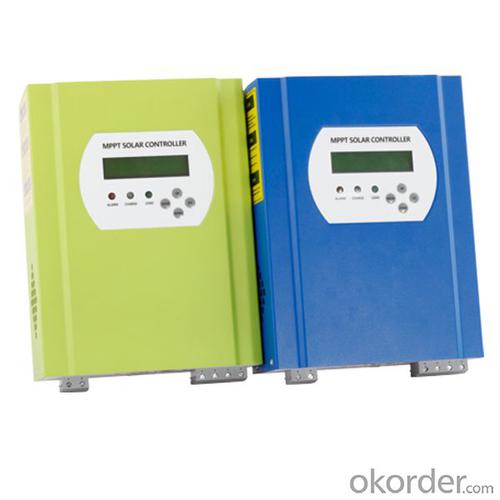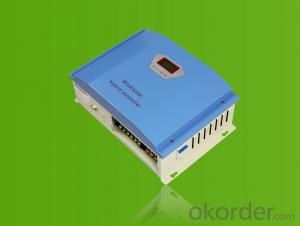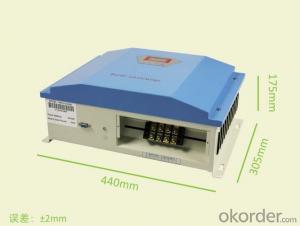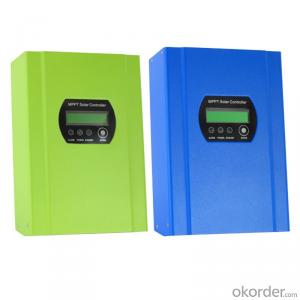Marine Solar Charge Controllers Smart2 30A Solar MPPT Battery Charger Controller DC 12V/24V/48V
- Loading Port:
- China main port
- Payment Terms:
- TT OR LC
- Min Order Qty:
- 20 unit
- Supply Capability:
- 9999 unit/month
OKorder Service Pledge
OKorder Financial Service
You Might Also Like
Smart2 30A Solar MPPT Battery Charger Controller
More Pictures

LAN/RS232 connecting


Upper PC software (real time monitor)

Application

Feature
1. MPPT charging mode, conversion efficiency upto 99%
2. Maximum PV input voltage up to DC150V
3. RS232 and LAN communication port
4.Discharge mode: ON/OFF mode, double time control mode, PV voltage control mode, PV voltage+time delay mode.
5.LCD and LED show various parameters
6. Controllers can be connected in unlimited parallels
7. CE,RoHS, FCC certification approved
8. 2 years warranty, lifelong free technical service.
Parameter
| Model:I-P-SMART2-20A/25A/30A -series | 20A | 25A | 30A | ||
| Charge Mode | Maximum Power Point Tracking | ||||
| Method | 3 stages: fast charge(MPPT),constant voltage, floating charge | ||||
| System Type | DC12V/24V/48V | Automatic recognition | |||
| PV Modules Utilization Rate | 12V/24V/48Vsystem | ≥99% | |||
| Input Characteristics | |||||
| MPPT Working Voltage and Range | 12V system | DC18V~DC150V | |||
| 24V system | DC34~DC150V | ||||
| 48V system | DC65~DC150V | ||||
| Input Overvoltage Protection Point | 12V/24V/48V system | DC150V | |||
| Max. PV Power | 12V system | 286W | 357W | 429W | |
| 24V system | 572W | 715W | 858W | ||
| 48V system | 1144W | 1430W | 1716W | ||
| Output Characteristics | |||||
| Selectable Battery Types | 12V/24V/48Vsystem | Sealed lead acid, vented, Gel, NiCd battery | |||
| (Default type is GEL battery) | (Other types of the batteries also can be defined) | ||||
| Rated Output Current | 12V/24V/48V system | 20A | 25A | 30A | |
| Physical | |||||
| Pc (communication port) | RS232 or LAN | ||||
| Measurement D*W*H(mm) | 220*165*70mm | ||||
| N.G(kg) | 2kg | ||||
| Color | Blue/Green/OEM (optional) | ||||
| Safety | CE, RoHS,FCC | ||||
Certifications |

F&Q: |
Q1. How to ensure and monitor the products quality?
A1: We have established a perfect Quality Management System, In strict
accordance with ISO9001: 2008 quality system and ISO14001 environment system for quality assurance management;
Our ISO9001:2008 Quality System certificate encoding: CHIN/TW/QMS/00119;
Our ISO14001 Environment System certificate encoding: CHIN/TW/EMS/00028;
Q2. What is the warranty of products?
A2: The warranty period of different products are different; 5 years, 3 years, 2 years, 1 years; More details please refer to the product specification or manual; we will provide free life-long technical support ;
Q3. What is the difference between MPPT&PWM?
A3. MPPT charging mode, peak efficiency up to 99%, saving 30%~60% solar panel than traditional PWM controller.
- Q: Can a solar controller be used with different types of solar panel fault detection systems?
- Yes, a solar controller can be used with different types of solar panel fault detection systems. A solar controller is responsible for regulating and controlling the flow of electricity between the solar panels, batteries, and loads. It typically monitors and manages the charging and discharging process of the batteries. Solar panel fault detection systems are designed to detect any faults or malfunctions in the solar panels, such as a decrease in power output, shading, or a broken connection. These systems use various methods to identify and diagnose these issues, such as voltage and current monitoring, temperature sensing, or advanced algorithms. A solar controller can integrate with different types of solar panel fault detection systems by receiving and interpreting the fault detection signals. It can then adjust the charging and discharging parameters accordingly to optimize the system's performance and protect the batteries from damage. The compatibility between the solar controller and the fault detection system will depend on the specific communication protocols and interfaces supported by both devices. It is important to ensure that the solar controller and fault detection system are compatible or can be integrated through the use of additional hardware or software interfaces. In summary, a solar controller can be used with different types of solar panel fault detection systems, provided that there is compatibility and proper integration between the two devices. This allows for efficient monitoring and management of the solar power system, ensuring optimal performance and protection against faults.
- Q: Can a solar controller be used with a generator or other backup power sources?
- Yes, a solar controller can be used with a generator or other backup power sources. The solar controller helps regulate the charging and discharging of the battery bank, ensuring proper management of power from the solar panels, generator, or other sources. This allows for an integrated and efficient utilization of renewable and backup power in off-grid or hybrid systems.
- Q: Can a solar controller be used in a standalone solar power system?
- A solar controller is a crucial element in a standalone solar power system, ensuring efficient and safe operation. It prevents battery overcharging, which can damage and shorten their lifespan. Additionally, it protects against over-discharging. In a system without grid connection or backup generator, the solar controller plays a vital role. It monitors and adjusts the charging rate based on solar panel voltage and current, preventing overcharging. It also safeguards the batteries from over-discharging. Furthermore, some solar controllers offer additional features like load control. This allows direct connection and power supply to DC loads from the battery bank. This feature proves useful in operating appliances or devices during times when solar panels are not generating electricity. In conclusion, a solar controller optimizes battery charging and discharging, ensuring long-lasting batteries and a reliable power supply in standalone solar power systems.
- Q: How can I determine the size of solar controller I need for my system?
- To determine the size of the solar controller you need for your system, you should consider two main factors: the maximum current and voltage of your solar panels. First, calculate the maximum current your panels produce by dividing the wattage rating by the voltage rating. Then, choose a solar controller that can handle this maximum current and voltage. It's always recommended to select a controller with a slightly higher capacity to allow for potential future expansions or efficiency losses.
- Q: Can a solar controller be used with different types of solar charge controllers?
- No, a solar controller is specifically designed to work with a specific type of solar charge controller and may not be compatible with different types.
- Q: How does a solar controller work?
- A solar controller, also known as a charge controller, regulates the flow of electricity between the solar panel and the battery. It ensures that the battery is charged efficiently and protects it from damage due to overcharging or overdischarging. The solar controller monitors the battery's voltage and adjusts the charging current accordingly. It also prevents reverse current flow from the battery to the solar panel during low or no sunlight conditions. Overall, a solar controller helps optimize the performance and lifespan of the battery in a solar power system.
- Q: Can a solar controller be used with solar-powered water purification systems?
- Yes, a solar controller can be used with solar-powered water purification systems. A solar controller helps regulate the flow of electricity from the solar panels to the purification system, ensuring optimal performance and preventing damage to the system.
- Q: How does a solar controller handle voltage drops in the system?
- A solar controller handles voltage drops in the system by regulating the flow of current from the solar panels to the battery bank. It ensures that the voltage level remains stable and adjusts the charging parameters accordingly to prevent overcharging or undercharging of the batteries. Additionally, some advanced solar controllers may include a feature called Maximum Power Point Tracking (MPPT) that optimizes the solar panel output by converting excess voltage into additional current, compensating for any voltage drops in the system.
- Q: How does a solar controller handle the logging of system data?
- A solar controller handles the logging of system data by continuously monitoring and recording various parameters such as solar panel voltage, battery voltage, charging current, load current, and temperature. It stores this data in its memory or an external storage device, allowing users to access and analyze the information for system performance evaluation and troubleshooting purposes.
- Q: How does a solar controller handle voltage drops in the wiring system?
- A solar controller regulates and manages the voltage output from solar panels. When there are voltage drops in the wiring system, the solar controller automatically adjusts the voltage to maintain a consistent and optimal level, ensuring efficient power transfer and preventing any potential damage to the connected devices or batteries.
Send your message to us
Marine Solar Charge Controllers Smart2 30A Solar MPPT Battery Charger Controller DC 12V/24V/48V
- Loading Port:
- China main port
- Payment Terms:
- TT OR LC
- Min Order Qty:
- 20 unit
- Supply Capability:
- 9999 unit/month
OKorder Service Pledge
OKorder Financial Service
Similar products
Hot products
Hot Searches
Related keywords
























